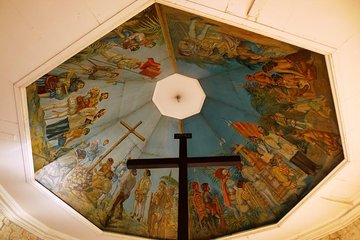Twin City Tour (Cebu City & Lapulapu)
Share this tour

Offered languages
- English
Explore the famous landmarks of these two híghly urbanized cities in Central Visayas Region and discover why Cebu City was declared as the “Queen City of the South” and Lapu-Lapu City as a “Historic Resort City”.
● Fort San Pedro / Plaza Independencia *
● Basilica Minore Del Santo Niño
● Yap - San Diego Ancestral House
● Heritage of Cebu Monument
● Taoist Temple *
● Magellan’s Cross
● Cebu Museum (Museo Sugbo)
● Mactan Shrine
● Alegre Guitar
What's Included
Meeting and pickup
Free Pick Up & Drop Off from any hotel within Tri-Cities (Mandaue, Lapu-Lapu, Cebu)
7:00 - 9:00 am hotel pick up
Itinerary
-
1
The Magellan Shrine is a large memorial tower erected in 1866 in honor of the Portuguese explorer Ferdinand Magellan on the Mactan Island of Cebu, the Philippines. The spot is believed to be the site where Magellan was killed in the 1521 Battle of Mactan.
1 hour • Admission ticket not included -
2Basilica del Santo Nino
The Minor Basilica of the Holy Child, locally known as the Basílica Minore del Santo Niño de Cebú and commonly known as Santo Niño Basilica, is a minor basilica in Cebu City in the Philippines that was founded in 1565 by Fray Andrés de Urdaneta and Fray Diego de Herrera. It is the oldest Roman Catholic church in the country, allegedly built on the spot where the image of the Santo Niño de Cebú was found during the expedition of Miguel López de Legazpi.
1 hour • Admission ticket not included -
3Taoist Temple
The Taoist Temple is the center of worship for Taoism, the religion which follows the teachings of the ancient Chinese philosopher, Lao Zi. In the temple, devotees perform rituals. One ritual is where one prays to the gods to grant one's wish.
1 hour • Admission ticket not included -
4Heritage Of Cebu Monument
The Heritage of Cebu Monument is a representation and illustration of sculptures depicting significant and symbolic events in the history of Cebu back from the time of Rajah Humabon to the recent beatification of the Cebuano martyr, Pedro Calungsod. The monument was built by the local artist, Eduardo Castrillo.
1 hour • Admission ticket not included -
5Yap Sandiego Ancestral House
The Yap Sandiego Ancestral House is a museum that sheds light on the Chinese settlements of the city. It is said to be among the first Chinese houses to be built outside of the country.
1 hour • Admission ticket included -
6Magellan's Cross
The Magellan's Cross Pavilion which houses the tindalo cross was built sometime in the 1800s. The structure is octagonal kiosk made of coral stone
1 hour • Admission ticket included -
7Museo Sugbo
Museo Sugbo is housed in what was once called Cárcel de Cebú, the provincial jail of Cebu. Designed in 1869 by Domingo de Escondrillas, the lone architect in Cebu at the time, the Cárcel de Cebú was originally proposed as the Cárcel del Distrito, the main prison for the Visayas District.
1 hour • Admission ticket included
Additional info
- Suitable for all physical fitness levels
Tags
Cancellation Policy
All sales are final. No refund is available for cancellations.
Show more
Cancellation Policy
This experience is non-refundable and cannot be changed for any reason. If you cancel or ask for an amendment, the amount you paid will not be refunded.
- This experience requires a minimum number of travelers. If it’s canceled because the minimum isn’t met, you’ll be offered a different date/experience or a full refund.
- This experience requires good weather. If it’s canceled due to poor weather, you’ll be offered a different date or a full refund.
You will not receive a refund if you cancel.
Your guide to the flawless travel experience

